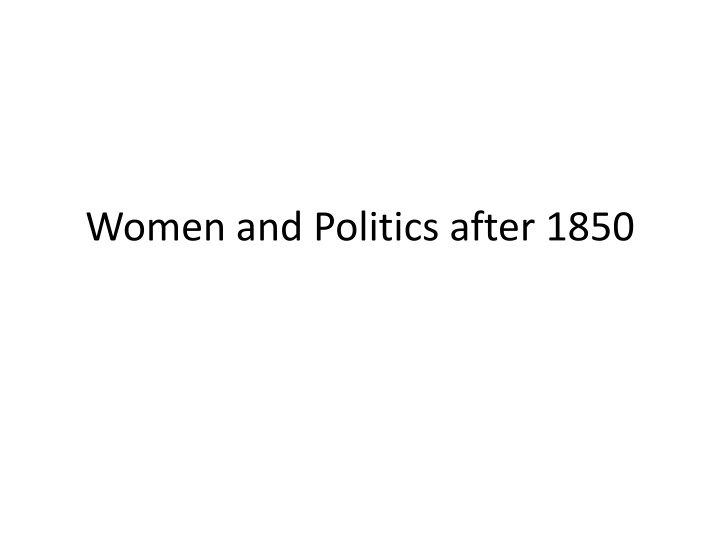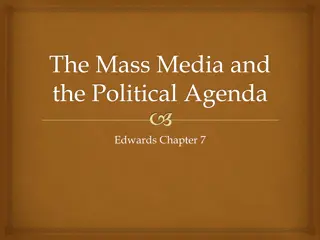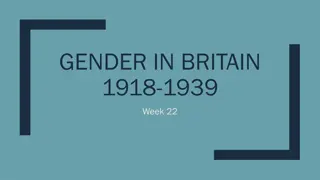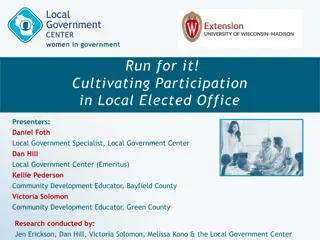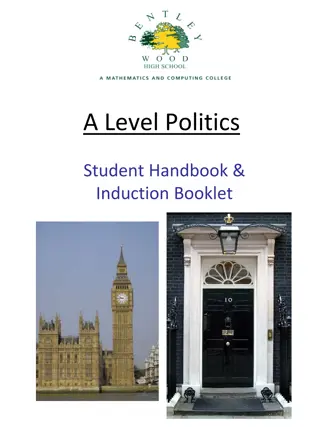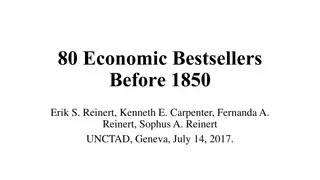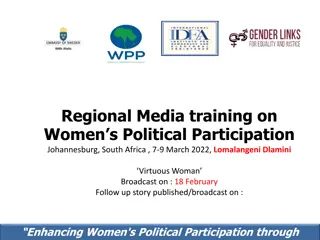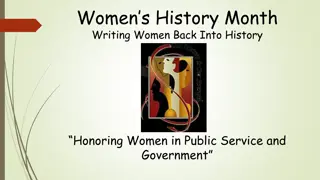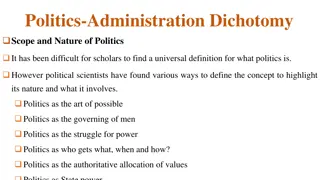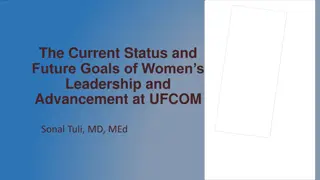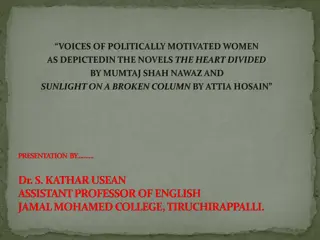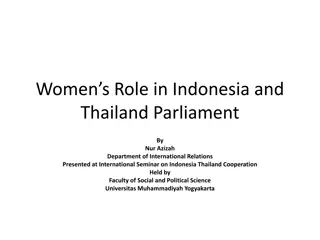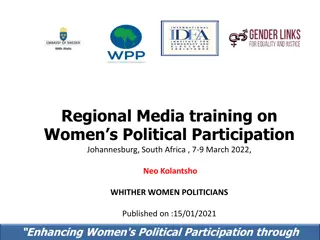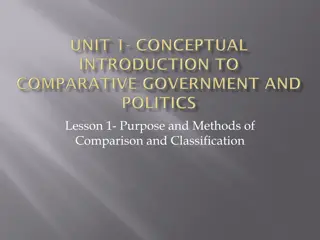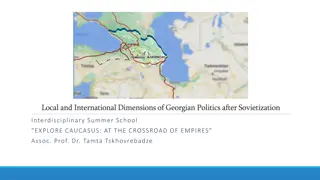Women in Politics and Local Government Post-1850
This overview explores the involvement of women in politics and local government after 1850 in the UK. It discusses their roles in local government reforms, including the Poor Law Amendment Acts and Municipal Corporation Act, as well as their participation in school boards and boards of guardians. Highlighted are key figures like Mrs. Constance Lees, the first woman elected to Oldham Council, and the debates surrounding women's suitability for these positions. The narrative reflects shifting societal norms and attitudes towards women's participation in governance.
Download Presentation

Please find below an Image/Link to download the presentation.
The content on the website is provided AS IS for your information and personal use only. It may not be sold, licensed, or shared on other websites without obtaining consent from the author.If you encounter any issues during the download, it is possible that the publisher has removed the file from their server.
You are allowed to download the files provided on this website for personal or commercial use, subject to the condition that they are used lawfully. All files are the property of their respective owners.
The content on the website is provided AS IS for your information and personal use only. It may not be sold, licensed, or shared on other websites without obtaining consent from the author.
E N D
Presentation Transcript
Overview Women and Local Government Women and the Liberal Party Women and the Conservative Party Women and Socialism Conclusion
Local Government Population growth and increasing urbanisation prompted reforms in local government: Poor Law Amendment Acts in 1834 and 1844 established Boards of Guardians elected annually to administer the new Poor Law. Municipal Corporation Act of 1835 reformed the government of around 200 towns and cities, replacing municipal corporations with elected councils. Local Government Act in 1888 reformed rural government providing for county councils. 1870 Education Act set up 2000 elected school boards in England and Wales (extended to Scotland in 1872)
Dickens parodied the notion of women s voters in local government The Election for Beadle by George Cruikshank, front flypagein Charles Dickens, Sketches by Boz
First woman, Mrs Constance Lees, to be elected to Oldham Council in 1907
School Boards Eleven women elected at the first school board contests in 1870 By 1902 when the school boards were abolished in England and Wales there were around 370 women members. In Scotland 17 women were elected in the first school board elections in 1873 Some observers were concerned about women standing for election others argued feminine influence on school boards was desirable Most candidates had considerable educational experience
Boards of Guardians Boards of Guardians administered the Poor Law Guardians dealt with the mentally unstable, the morally suspect, and the workhouse 1875 first woman, Martha Merrington, was elected as a poor law guardian Many male guardians argued that women were unsuited because of the subjects that would be discussed. Women countered that managing workhouses was akin to household management Numbers of guardians rose steadily to around 900 by 1895
Why should women be on a Board of Guardians? Because the larger number of Paupers are women and children. Because the care of the poor, the aged, the sick, and the miserable devolves on Guardians. An important part of the work of Guardians is the election of nurses and female servants. In the great matters of housekeeping, clothing, and education the matron and the house committee are obviously entitled to the assistance of WOMEN GUARDIANS. Campaign poster from Louisa Edwards, St Pauls Parish, Bedford, 1887
Councillors London County Council established as a result of the 1888 County Councils Act. The 118 councillors were elected by household suffrage with female ratepayers eligible to vote New County Councils Act stated that every person shall be qualified to be a councillor who is qualified to elect to the office of a councillor . The Society for Promoting the Return of Women as County Councillors put forward Jane Cobden as a Progressive candidate in Bow and Bromley, with Lady Sandhurst standing for Brixton. Both women were elected and the Council then co-opted Emma Cons a prominent Liberal philanthropist as an alderman.
Knowing that the Council, as a body, did not wish to exclude women from their rights of citizenship, I have done my best to justify the confidence they placed in me by serving them to the best of my ability during the past year, though under extremely disadvantageous circumstances My feelings on the subject of women councillors are as strong as ever, and I shall neglect no means in my power to secure a perfect freedom of choice to the ratepayers, and equal municipal rights for women as for men. It is a bitter experience when one for the first time fully realizes that even a long life spent in the service of one s fellow citizens is powerless to blot out the disgrace and crime (in the eyes of the law) of having been born a woman. Emma Cons
Women and Liberal Party National Liberal Federation established in 1887 Westminster Review reported that over 10,000 women joined local groups In 1886, Sophia Fry drew local associations into a single affiliate organisation Catherine Gladstone was its figurehead president Membership was 75,000 in 1892, peaking at 133,215 in 837 local associations in 1912 Aimed to be inclusive and attract a diverse membership Local branch subscriptions were kept low and could be waived for less affluent members. Women with more radical views and working-class activists were not tempted to join instead joining local socialist groups
Women and Conservatism After 1918 success of the Conservative party in electoral terms was due to female members and voters Gerry Maguire cautioned history of feminism should not be the history of left-wing feminism alone Attractions of conservatism for many female activists included imperialism and maternalist policies Female conservatives wary of being labelled as women s rights campaigners Emily Davies and Frances Power Cobbe preferred quiet lobbying rather than mass meetings
Primrose League Primrose League characterised by Martin Pugh as a party within a party Founded in 1883 in England and 1884 in Scotland Had a vague ideology of defending tradition which focused around crown, church and empire League embraced medieval terms and language: branches were termed habitations and members Knights or Dames. It was ruled by a Grand Council and members paid an annual tribute rather than a membership fee By the early 20th century membership exceeded 1 million By 1892 the Ladies Grand Council had its own touring propaganda van. Primrose Cycling Corps enabled women to undertake mobile propaganda closer to home. Suffrage issue divided Conservative women, just as it did Liberals. In 1908 a group of suffragists formed the Conservative and Unionist Women s Franchise Association
Primrose League Cycling Corps badge The Headington Buds (junior Primrose League group) Primrose League tea party
Conclusion Women s political activism due to rising number of parliamentary voters after the Reform Acts of 1832, 1867 and 1884; rise in local government organisations; rise in contested elections and transformation of political parties Women remained outside the political establishment but had more opportunities to engage in collective political activism Political activism dominated by middle-class and elite women Philanthropic work bridge to local government Women drawn to suffrage campaigns as they became acutely aware of the lack of women s political rights and the limitations of their activism
